Hamster Clan
back to Japan 2009 - Training Day 2
copyright © 2009 Patrick Suen, all rights reserved
|
Sunday, July 12, 2009. It's the start of our second week in Asia
and third day in Tokyo. I guess we'd planned pretty well the past
two trips, this time, and in 2007. Spending our first several days
in Hong Kong has allowed us to adjust to the flipped time zone so
we could commit all our energy on training while in Japan. We hadn't
gotten a chance to do any Iaido in Hong Kong, but I'm hoping that's
going to change in the future.
Waking up at 9am after a long day of Iaido (Read about that here:
http://ejmas.com/pt/2009pt/ptart_suen_0909.html)
was not how we'd hoped to spend our vacation. Our expectations were
not as high as yesterday, seeing as we were going to be doing only
Jodo today (an introductory lesson), as opposed to our much-preferred
martial art, Iaido. (Michael and I at four and a half years, Nidan,
and Hanna at two and a half years, Shodan). Little did we know that
this would turn out to be one of our best days in Japan yet!
On our way to Shinjuku train station from our hotel, there is a nice
corner Ramen store. As this was one of our main reasons for coming
to Japan (next to Iaido and Sushi, not necessarily in that order),
brunch here was a no brainer.... And it was AWESOME! Hey, maybe the
day would turn out fine after all. :)
|
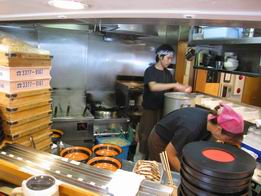 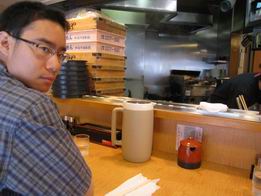
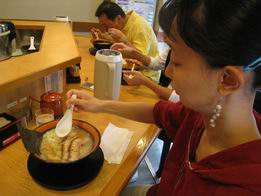 |
|
Our directions for getting to the training site, JAL Airlines building,
were a mixture of train and monorail. Tsubaki Fumio-sensei (Iaido
Kyoshi 7 Dan, Jodo Kyoshi 7 Dan) would not be able to meet us at the
monorail station, because there was someone important he had to be
with prior to our arrival. In turn, his student, Fukumi Ken (Iaido
4 Dan, Jodo 2 Dan) was to be our guide. Seeing as we'd been there
a year and a half ago, we weren't too worried about getting lost.
We ended up being too punctual and bumped into Tsubaki-sensei getting
off the monorail, not realizing we were on the same train for the
past 15 minutes. Another nice surprise. ^_^
|
|
Other members of the dojo started showing up for their own practice
- studious people who, as we later found out, were front runners to
win their divisions in the following week's Tokyo Region Jodo Taikai
(tournament). Also in attendance was Yoshimura Kenichi-sensei (Iaido
Kyoshi 8 Dan, Jodo Kyoshi 7 Dan) who practiced Iaido by himself.
We waited patiently for Tsubaki Sensei to come up from lunch for
our own personalized Jodo class. To our surprise the plans had changed.
We were still to have our Intro to Jodo, but it wouldn't be taught
by Tsubaki-sensei. Instead, he was able to invite Shiiya Mitsuo-sensei
(Jodo Hanshi 8 Dan, Iaido Kyoshi 7 Dan) to be our instructor. Shiiya-sensei
had come to the Sei Do Kai Spring Jodo Seminar in Guelph, Canada,
in the past and even presented Hanna with his calligraphy of the word
"Yume" (Dream). Needless to say, we were delighted at this
turn of events, and extremely grateful to Tsubaki-sensei for arranging
it.
As I count it, that's the 3rd nice thing to happen to us today, and
it's only 1pm!
|
 |
|
The class began with a demo from everyone present from 2 Dan up to
7 Dan. We got to see all the basic movements in Seitei Jo, performed
as a drill across the room, followed by 11 of the 12 Seitei kata,
performed in pairs. After that, the others went into the big gym for
their own practice, while the three of us proceeded to learn as much
as we could in our first Jodo class with Shiiya-sensei.
Our lesson began with us acting out a few of the basic movements
that we had just seen previously. Emphasis was on proper posture and
large, almost exaggerated movements. Like Iaido, we were told to make
it big and relax our bodies. In fact, there was quite a bit we could
transfer over from Iaido practice, so things weren't hard to pick
up. Sensei demonstrated how good tenouchi (grip) can give power to
our swings and thrusts, while wrong tenouchi is pretty much useless.
After a short break, Sensei taught us the first two kata in the ZNKR
Seitei set: Tsuki Zue and Suigetsu. We learned only the Jo portion
of the kata (as these are two-person sets, it requires someone with
a bokken), with Sensei as our opponent. Taking turns, we were given
instruction on how these techniques require proper understanding of
timing, distance and power.
Near the end of our training session, Sensei decided to demonstrate
how "real" Jodo should feel when done correctly. It went something
like this:
Shiiya Sensei - "blah blah blah" (Japanese)
Me - "Ah, yes." (Nods and looks at Hanna for translation)
Hanna - "He says he's going to hit you"
Me - "wut?.." (Spins head around to look at Shiiya Sensei)
** POW ** !!!
Michael - "heh" (Smiles as my breath is knocked out of me)
** POW ** !!!
Hanna - "..." (Knows that she's next)
** POW ** !!!
Laughs all around... More from Sensei than from us. Funny guy. No,
really - he is.
We were then treated to demos of the seitei kata at the end of class
again, this time with each rank performing a different number. Ken
and his partner Kotani Jun (Aikido, Jodo 2 Dan) demonstrated Katas
1-2. A pair of 3 Dans, including Yoshimura Sensei's wife demonstrated
Katas 3-6. Finally a pair of 5 Dans demonstrated Katas 7-10.
Jodo is an intriguing martial art, one which, in my brief experience,
seems the most complementary to Iaido in the Kendo Federation. Where,
initially, I saw how our Iai training helped us pick up Jodo faster,
we've also discovered a couple of concepts that would assist our progress
in Iaido training, as well.
|
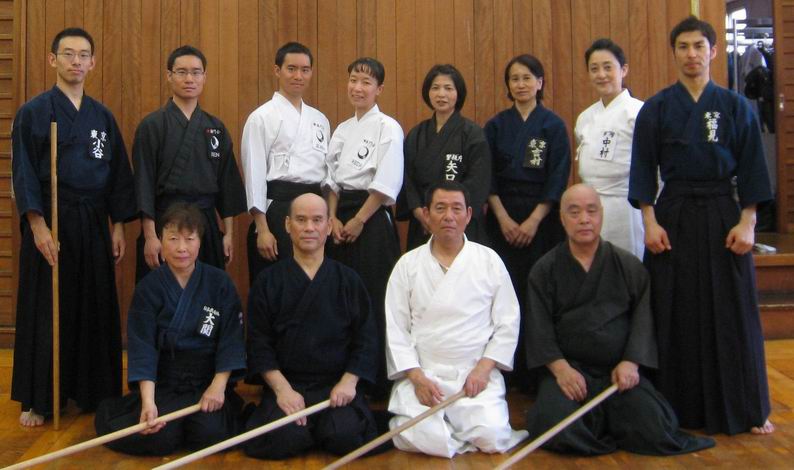 |
 |
With a hard practice behind us, we celebrated with some beer and
liquor-infused chocolates. The senseis and students had a great time
joking around, although occasionally the conversation would turn serious.
What I could get out of it was the talk invariably returned to Iaido
or Jodo. Great to see that even after so many years (decades?) the
passion for the art is still there.
As we all headed out of the building, Shiiya-sensei asked about our
plans for the rest of our stay in Tokyo. Tsubaki-sensei told him that
we had several days of Iaido lined-up and also planned on watching
the Jodo Taikai on Saturday. It turned out, Shiiya Sensei will be
doing the final demo at this taikai, so we were encouraged to make
an appearance. At the same time, we were also told that he'd be coming
to Toronto in September for the Annual Aikido Yoshinkai Canada Fall
Jodo Seminar. I'm not sure how much Jodo we'd be able to do between
now and then, but I think we'll attend at least one session just to
see the Sensei again.
|
|
After a full afternoon of training, with only some beer and chocolates
to tide us over, food was definitely on our minds. Arriving back in
Shinjuku, we decided to look around for some authentic Japanese fare,
and ended up going to a Shabu-Shabu joint on the eighth floor of a
building. So what is Shabu-Shabu?
As with most Asian cultures, the Japanese have a style of cooking
(which they call "Nabemono"), where food is cooked at the
table in one big pot of boiling water or soup. This type of cooking
is also commonly referred to as "Hot Pot". The most popular
types of hot pot in Japanese cuisine are Shabu-Shabu and Sukiyaki.
Both types use thinly sliced pieces of meat (beef, chicken, pork,
lamb) and vegetables.
Generally, Shabu-Shabu tends to be more savoury in taste and is cooked
relatively quickly (The term Shabu-Shabu refers to the motion of swishing
the food in the boiling water). Sukiyaki, on the other hand, is generally
sweet and slowly cooked in a simmering pot of soup base.
|
 |
|
The food was delicious, but we were not quite satisfied yet. We started
walking back to the hotel, making sure to keep our eyes open for good
looking dessert joints. Approaching the south entrance of Shinjuku
train station, we stumbled upon a small crepe counter nestled between
an udon restaurant and a convenience store.
As we were making the purchase, some singing caught our attention.
Now, we know it's common for artists to perform all over the streets
of Japan, ranging from acrobatics, to magic tricks, and even comedy
duos. The tendency, however, is they all blend into the background
noise of the people, trains and pachinko parlours. Not this time!
The woman's voice was beautiful. We ended up staying in the crowd
until her last performance, a self-written, soulful tune called "soba
ni". As she started packing up, we quickly went over to purchase
her two latest CDs and took a couple of pictures for memento.
What a great ending to a great day! We learned a new art and met
some wonderfully talented and friendly people along the way.
|
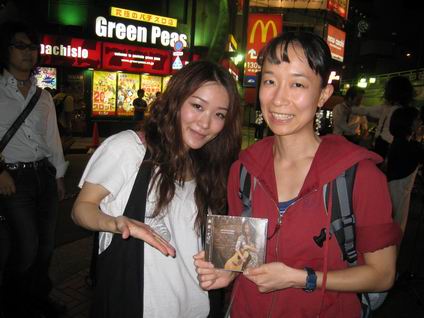 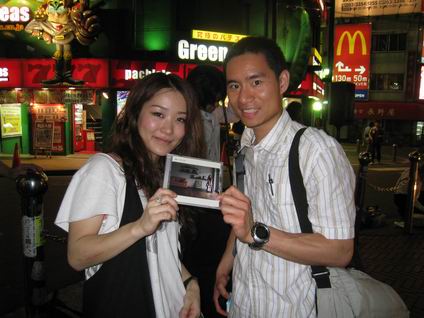
|
|
Stay tuned for
Training Day 3 - Iaido without Air Conditioning
|
|